14 Types Of Grapefruit You Should Know

Known for its sweet and tart flavor, and once used mainly as an ornamental plant, and it's taken some time for grapefruit to be grown for the same culinary considerations as other citrus fruits. Despite its modern popularity, the grapefruit is one of those controversial foods that folks can't seem to agree on. It's right up there with cilantro, Brussels sprouts, and pineapple on pizza.
Some people love the fruit's acidity, while others find it extremely bitter. This bitter flavor is actually due to naringin, a compound that some individuals are more sensitive to. If you're in that boat, you'll be glad to know that there isn't just one type of grapefruit available. There are many varieties, which range in sweetness and acidity. You can even find grapefruits with different flesh colors, from red and pink to yellow and white.
If you can discover a grapefruit variety that tastes good to you, it's certainly worth adding to your diet. Grapefruits are particularly high in essential nutrients, including immune-boosting vitamin C, gut-friendly fiber, and heart-friendly potassium. Red and pink varieties also offer lycopene and beta-carotene, while white and yellow grapefruits have xanthophyll. These compounds are carotenoids, or antioxidant plant pigments that reduce the risk of disease. Antioxidants work by protecting your cells from damage, ultimately keeping them healthy. In other words, all types of grapefruits are good for you, so it's worth exploring the different varieties available.
Read more: 13 Simple Tricks To Pick The Best Fresh Fruit Every Time
Ruby Red Grapefruit

When you think of grapefruits, there's a good chance Ruby Red comes to mind. It's one of the most common types of grapefruit, and for good reason too; the Ruby Red was the variety that popularized the citrus fruit. Throughout the 1800s, the grapefruits in the U.S. were white and pink varieties, which were too sour for people's liking. However, in 1929, a sweeter mutation was discovered on a pink grapefruit tree in south Texas. This anomaly — which was called Ruby Red due its dark red flesh — became a hit due to its sweet flavor, shooting the grapefruit to citrus stardom.
In fact, the Ruby Red was the first grapefruit to receive a patent. And since the mutation was discovered in Texas, it's no wonder most of today's Ruby Red grapefruits come from the state. This variety falls within the Ruby-Sweet category, one of the three trademarked groups of grapefruits. Also known as the redblush grapefruit, the Ruby Red has a seedless red flesh, which might vary between pink and light red depending on the time of the growing season.
Henderson Grapefruit
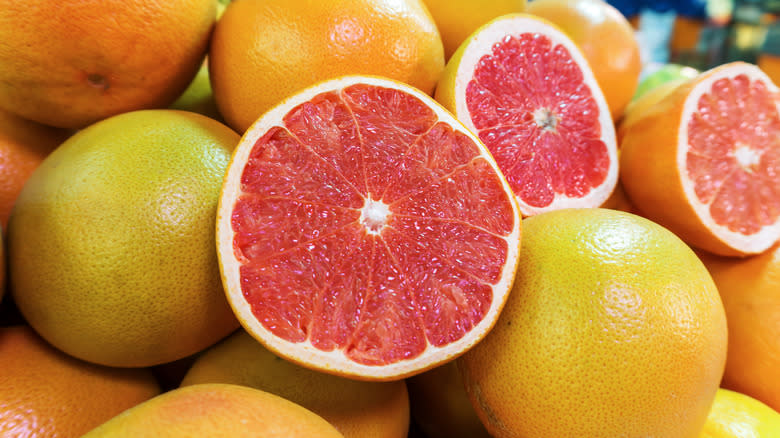
The Henderson grapefruit is another variety that falls under the Ruby-Sweet category of Texas grapefruits. It's seedless like the Ruby Red, though its red flesh is about three to five times darker. This is noteworthy if nutrition is a priority for you, as redder grapefruit flesh has more lycopene, the antioxidant nutrient that makes red fruits and vegetables so good for you.
The peel is smooth and yellow with a pretty red-pink hue, making it a common addition for fruit displays and gifting. If you're curating a fruit basket or arranging a fruit bowl for aesthetic purposes, consider adding a Henderson grapefruit to the lineup. At the grocery store, you might find Henderson grapefruits listed as Ray Ruby; the latter is a different cultivar in the Ruby-Sweet category, though it's very similar in taste and looks. Due to this, Henderson grapefruits are sometimes called "Henderson and Ray" to encompass both varieties.
Rio Red Grapefruit
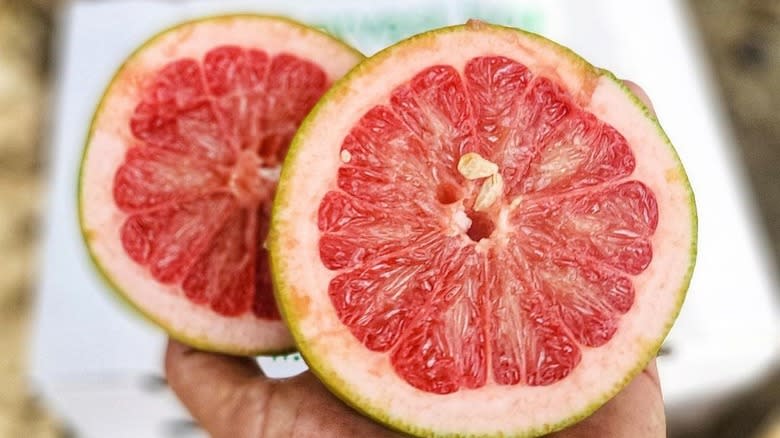
The Rio Red grapefruit is another major type of grapefruit in the U.S. It's part of the Rio Star category, one of the three trademarked grapefruit categories. This variety is the most commonly grown grapefruit in Texas, California, and Arizona. Made available by Texas A&M University in 1984, the Rio Red is a natural mutation of the Ruby Red, meaning it happened spontaneously without the help of scientists. Because of this, the Rio Red has similar characteristics to the Ruby Red, most notably a red flesh. However, its flesh is even darker, about seven to 10 times deeper than the Ruby Red.
This grapefruit variety has a pebbly yellow peel with a pink blush, so it's an attractive choice for gifting. It's also described to a have a sweet-tart and somewhat bitter, making it an ideal option if you don't enjoy the intense acidity of other grapefruits.
Star Ruby Grapefruit
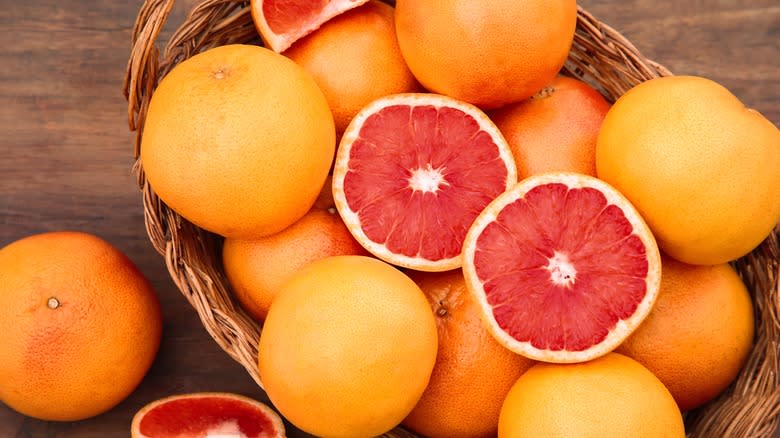
Released by the breeding program at Texas A&M University in the 1970s, the Star Ruby grapefruit came from the Hudson variety. Scientists created it by mutating a Hudson seed with irradiation. Compared to other varieties, the Star Ruby grapefruit is typically smaller and trickier to grow, as it's more prone to pest issues, nutrient deficiencies, and phytophthora, also known as root rot.
As the darkest red grapefruit, the Star Ruby is revered for its vibrant red and seedless flesh. In fact, the pulp is darker, sweeter, and tarter than the Red Ruby. The redder flesh indicates a higher level of lycopene, so you can be sure this variety will pack the nutritional punch. The peel, like many other types, is yellow and smooth with a reddish blush. The Star Ruby grapefruit is primarily grown in Texas, where the fruit is labeled as "Texas Star Ruby." Instead, it has gained attention in other countries, including Cyprus, Spain, Turkey, Australia, South Africa, and Israel.
Duncan Grapefruit

The Duncan grapefruit is categorized as a type of white grapefruit, though its flesh is more of a pale yellow. This coloration is due to xanthophyll, a plant pigment that gives fruits a yellowish color. The fruit has many seeds, a juicy texture, and a similar flavor to its seedless counterparts. It's also a significant variety in the world of citrus, as it's thought to be the oldest type of grapefruit cultivated in the U.S. Case in point: The first tree that produced Duncans was planted in 1830, long before grapefruits were popular, and many of today's popular seedless and pigmented grapefruits are actually mutations of the Duncan.
Despite the Duncan grapefruit's important role, you probably won't find it in the supermarket, as the variety is typically grown for canning and juicing. But if you're lucky enough to live in a warm area where grapefruits can thrive, it's possible to buy a Duncan grapefruit tree and grow your own white grapefruits. Note that white grapefruits are exceptionally tart, so you may want to pair it with sweeter ingredients to balance the flavor.
Flame Grapefruit
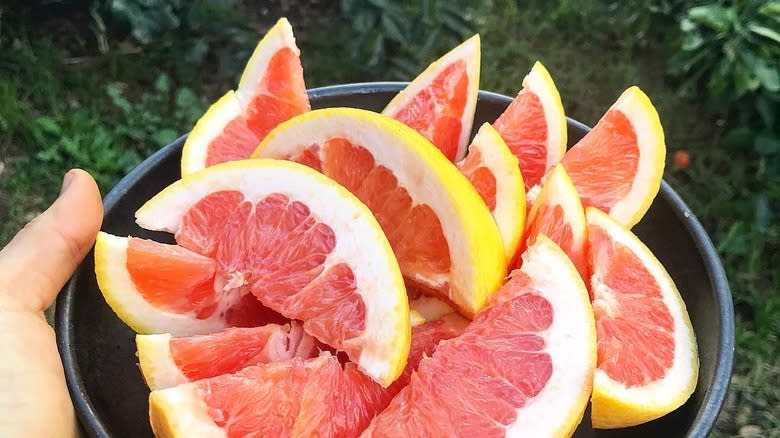
Discovered in Texas, the Flame grapefruit is another mutation of the Ruby Red variety. It was officially released in 1987, and since then, it has become a major type of grapefruit in the U.S. But unlike other grapefruits, the Flame variety isn't available all year round; it's typically only available between October and May.
The fruit is medium-sized, juicy, and seedless, making it a beloved variety among citrus fans. As the name suggests, it has a striking red flesh which is darker than Ruby Red and similar to Star Ruby and Rio Red. Due to this bright color, the Flame grapefruit is excellent for adding a pop of color to dishes like salads and grazing boards. You can also use it to intensify the hue of pink grapefruit drinks if you enjoy making them at home. Even the peel is attractive, as it boasts a yellow hue with eye-catching pink blush.
Marsh Grapefruit
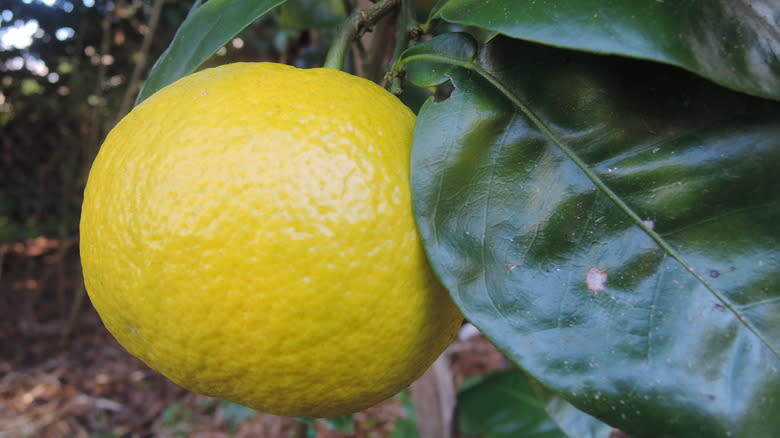
In addition to the Duncan grapefruit, the Marsh is the other type of white grapefruit grown in the U.S. It's also known as the White Marsh, Marsh Seedless, Whitney Marsh, Zinbaa Rose, and Marsh Jibarito. The Marsh is noteworthy in the world of citrus, as it was the first ever seedless grapefruit to be discovered. It was found in 1850 in Lakeland, Florida, though it didn't become popular until 1886. In fact, it replaced the seedy Duncan grapefruit as a prominent white variety, thanks to its seedless nature. The Thompson grapefruit, or Pink Marsh, can be traced back to this variety.
Featuring a smooth, pale yellow peel, the Marsh grapefruit has a yellow flesh that's so light, it's almost white. It's also quite different from the Duncan, a fellow white grapefruit, as it's smaller in size and has a thicker peel. The flavor is sweet-tart, so it's a great variety if you enjoy sharper notes. White grapefruits like the Marsh are difficult to find in stores, but if you live in a warmer climate, you might be able to buy a tree and grow the fruit at home.
Oro Blanco Grapefruit
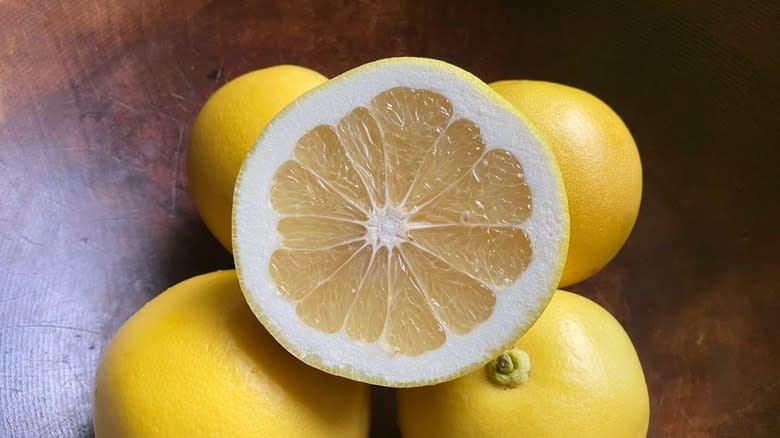
In the U.S., there are two main grapefruit hybrids that are available commercially. One of them is the Oro Blanco, which is sometimes spelled "Oroblanco," a seedless cross between a white Marsh grapefruit and a low-acid pomelo. It was made by the University of California in 1958 and then released in 1980. The fruit has a green-yellow peel that's thicker than grapefruits but thinner than pomelos. Otherwise, it's more like a white grapefruit than a pomelo due to its light yellow flesh.
In terms of flavor, the Oro Blanco is sweeter and less tart than its parent, the Marsh grapefruit. This makes it ideal if you're not a fan of acidity and looking for a sweeter grapefruit flavor. With that in mind, in the U.S., Oroblanco grapefruit are sometimes sold as white grapefruits in grocery stores, so be sure to check the label before purchasing. This variety is called "Sweetie" in Israel.
Melogold Grapefruit
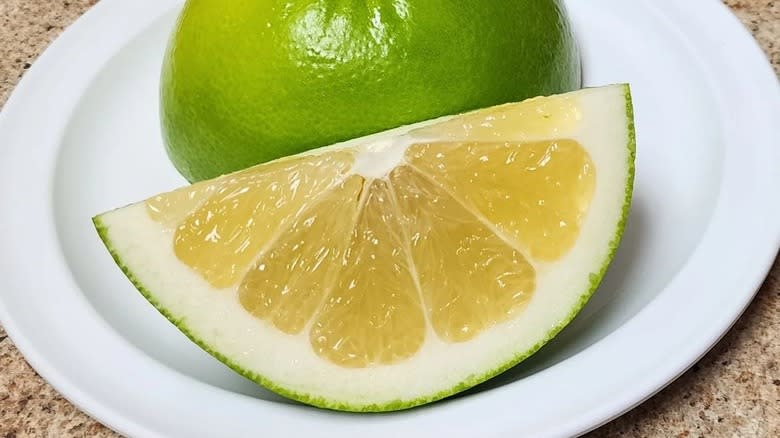
In the U.S., the Melogold is the other major grapefruit hybrid. Like the Oro Blanco, it was created at the University of California, though it was released a few years later, in 1986. It's also a cross between a seedy Marsh grapefruit and a low-acid pomelo. However, whereas the Oro Blanco closely resembles a grapefruit, the Melogold is more similar to a pomelo. Compared to Oro Blanco, it's also 25% bigger, has a milder taste, and contains more sugar, so it's less tart than Oro Blancos and grapefruits in general.
The name "Melogold" comes from its flavor and color. "Melo" is derived from "mellow flavor," which stems from its low acidity. The "gold" part is a nod to the intense gold color of the rind, which is darker than the Oroblanco. This variety will shine when paired with tangy ingredients, such as Greek yogurt, as its sweetness can help balance any acidity.
Ugli Fruit
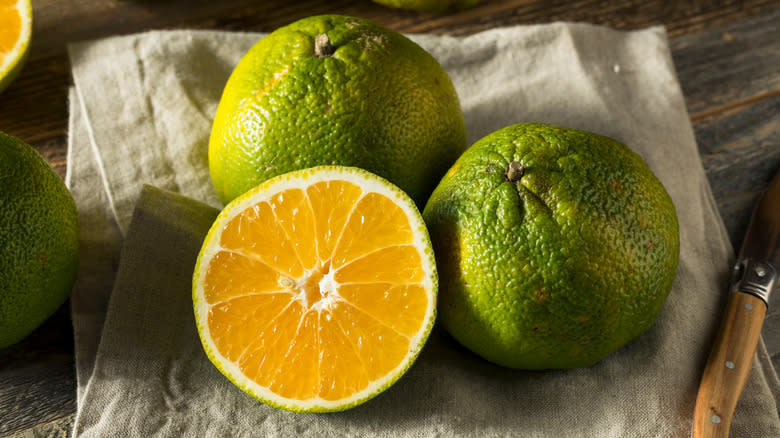
The ugli fruit is a type of tangelo, or a hybrid between a grapefruit (i.e., pomelo and orange) and a tangerine. It was discovered in 1924, growing in the wild in Jamaica, so it's also known as a Jamaican tangelo. The name "ugli" is a reference to its bumpy, wrinkled, and "ugly" peel, which might even have scars and discolored or green spots. But don't let its strange appearance fool you; the ugli fruit is quite delicious. The flavor is a sweet mix of orange and grapefruit, so you'll likely enjoy the fruit if you're a fan of orange notes. What's more, the sweetness increases the older it appears, so don't hesitate to pick the particularly "ugly" ones.
Beyond flavor, the ugli fruit bears similar characteristics to other citrus fruits. The peel is rough, like an orange, but smells like lemon. Additionally, some ugli fruits are small like oranges, while others are large, about the size of grapefruits. They're also eaten fresh, in salads, or juiced, but they can be broiled for a sweet and unique citrus dessert.
Thompson Grapefruit
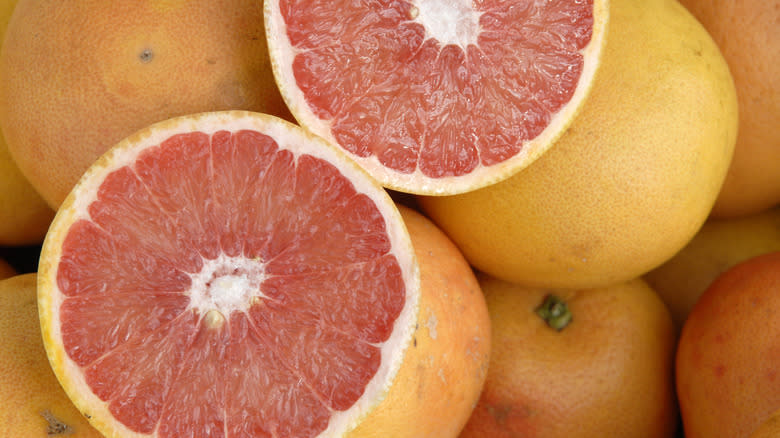
Sometimes called Thompson Pink or Pink Marsh, the Thompson was the first seedless pigmented grapefruit. It's was discovered and released in 1924 by a nursery in Florida, and it's a natural mutation of the white Marsh grapefruit. At the time, the Thompson became popular due to its seedless nature and soft pink flesh, and it was eventually used to breed more pigmented varieties. This includes the well-known Red Ruby, or redblush, grapefruit.
As a relative of the Marsh grapefruit, the Thompson has many of the same characteristics, except for its pink pulp. The exact shade of pink depends on the area the grapefruit was grown, as it can vary from pale to dark pink. Otherwise, the flesh is juicy and has a similar flavor to the Marsh, making it ideal if you enjoy the Marsh's sweet-tart flavor but are looking for a burst of pink in your dishes.
Foster Pink Grapefruit

A medium-large variety, the Foster pink grapefruit came from the Duncan grapefruit. Despite its name, the flesh is typically a pale yellow hue called chamois, but it will turn light pink if the tree is grown in the right conditions. This pink color is faint and lighter than the hue seen in other pink varieties. As a relative of the Duncan, the Foster pink grapefruit is also very seedy, so you might want to skip this variety if you don't want to bother with the seeds.
This type of grapefruit is significant in Florida because it was the first pigmented grapefruit found in the state. It was found in an orchard in Florida in 1907, then released by a nursery several years later in 1914. Eventually, the Foster became less popular when Thompson came around, which is both seedless and pink. Due to this, Foster pink grapefruits are rarely planted, so you'll have to buy a tree to enjoy this fruit.
Wheeny Grapefruit
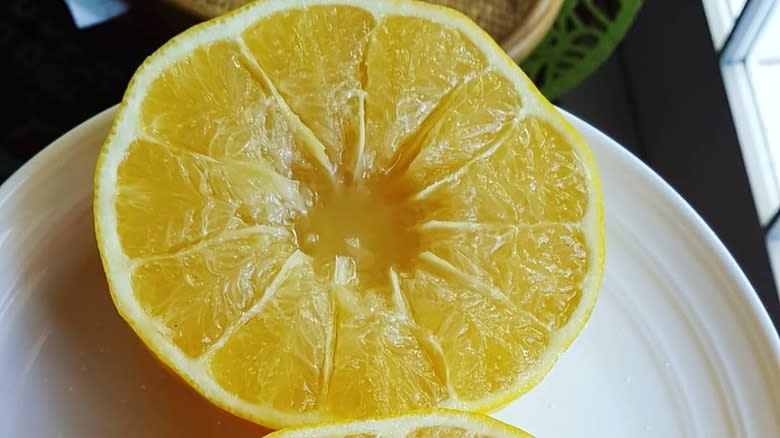
Discovered in New South Wales, Australia, at Wheeny Creek, the Wheeny grapefruit was found as a chance seedling. This means it's the product of accidental breeding. Botanically, it's considered a pomelo hybrid, though it's often called a grapefruit because of its similarities to the fruit. For example, like other types of grapefruits, it has a juicy, acidic flesh. It's also large in size, despite its name. Otherwise, its pale yellow peel is rougher than most varieties, and its flesh is light tan, almost like the color of straw.
The Wheeny grapefruit is unique in that it can thrive in cooler temperatures, as well as warm and subtropical climates. It does particularly well in New Zealand and southern California, so if you're in either area, you may be lucky enough to find the fruit in stores. The fruit bears no bitter notes, though it has a lot of seeds, so it might be difficult to eat fresh. Consider using this variety in a juicer so the appliance can easily remove the seeds for you.
Triumph Grapefruit
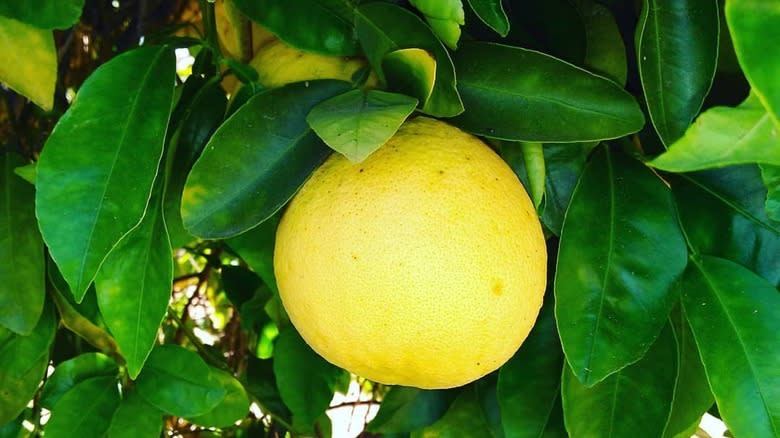
Officially named in 1884, the Triumph grapefruit was the first variety to receive a name. The tree was discovered in Tampa, Florida, and it's thought to be a grapefruit-orange hybrid due to its strong orange flavor. It's also very sweet and not bitter like typical grapefruits, and the fruit itself is small and round like an orange. The fruit has many seeds, however, so it might be a nuisance to eat.
Also known as Early Triumph, this variety isn't commercially popular, so it isn't found in stores, especially as seedless types have since been released. But it's possible to buy and plant a Triumph grapefruit tree in your own orchard or yard. And if you ever visit South Africa, keep an eye out for the Jackson LS grapefruit, which is sold under the trademarked name of Sweet Sunrise. This variety came from the Triumph grapefruit, but it's been bred to have no seeds.
Read the original article on Tasting Table


